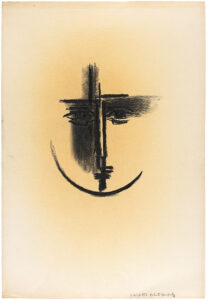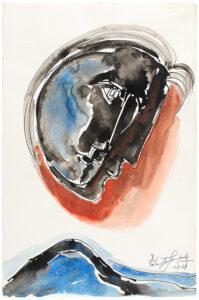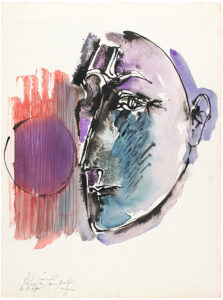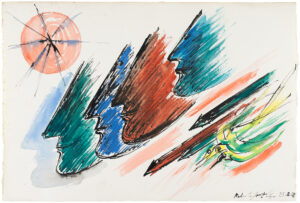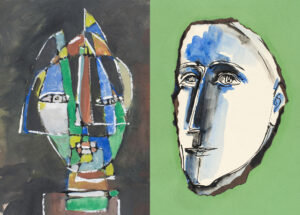Roberta González
c.1938-1941

Roberta González
(1909-1976)
Roberta González was a French painter from the Catalan community in the Montparnasse neighbourhood of Paris. Her distinctive body of work, punctuated by women, birds, signs and forms, offers a unique synthesis of figuration and abstraction.
Exhibitions
Publications
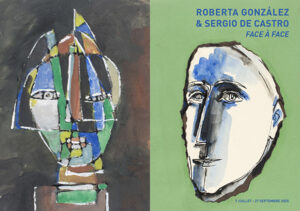
ROBERTA GONZÁLEZ & SERGIO DE CASTRO
Face to face
Digital publication – Text by Mathilde Gubanski
Roberta González’s family life and artistic training
Roberta González, the only daughter of the Catalan sculptor Julio González (1876–1942), was born in Paris on 13 September 1909. Roberta grew up within the French capital’s Catalan community, where art played a central role in her upbringing: in addition to her father, a sculptor, Roberta’s uncle Joan González (1868–1908) was known for his drawings, and her aunts, Lola and Pilar, worked in fashion and crafts. Pablo Picasso, a long-standing friend of Julio’s, regularly visited the family home and is said to have encouraged the young Roberta to try her hand at drawing. Roberta González naturally pursued the family’s artistic vocation, supported by her father, who treasured her childhood drawings and told her: “You will be a painter, and you will accomplish as a painter what neither your uncle nor I have been able to express in painting.” A drawing by Roberta from 1918 was even published in 1924 in the journal Les Feuilles libres: lettres et arts to illustrate “Les Enfants” by André Lhote. The attention and encouragement Roberta received from her father were all the more important as she was abandoned at an early age by her mother Louise “Jeanne” Berton. “My aunts are my real mothers,” Roberta wrote in her notebooks. “The other one is completely indifferent to me.”
From 1927, Roberta González attended courses at the Académie Colarossi, a Paris art school founded in 1870 by the Italian sculptor Filippo Colarossi. This co-educational academy allowed female students to paint and sculpt from nude male models. Camille Claudel, for example, was one of the best-known artists to have attended the academy. Renowned for its life sculpture classes, the school attracted students from around the world. In 1907, the academy appointed its first female professor, New Zealand artist Frances Hodgkins, thus confirming its progressive spirit.
War and exile for the González-Hartung family
In the 1930s, Roberta adopted an artistic style influenced by Cubism and Surrealism. When the Spanish Civil War broke out in 1936, Picasso, Julio and Roberta González expressed their support for Republican Spain through their work. Julio González and Pablo Picasso jointly represented democratic Spain at the Exposition Universelle in Paris in 1937. In support of the Spanish people, Picasso presented his masterpiece Guernica, and González exhibited his iron sculpture La Montserrat. For her part, Roberta González painted mother-and-child scenes and peasant women with angular features, as tributes to Catalan women.
In 1936, Roberta’s only iron sculpture was exhibited alongside her painting Femme assise in the exhibition L’art espagnol contemporain at the Musée des Écoles Étrangères contemporaines (the future Musée du Jeu de Paume). The sculpture was acquired by the French state. Although born in France, Roberta was from the outset considered part of the Franco-Spanish art scene.
In 1937, Hans Hartung, an abstract painter, was introduced to Julio González, whose work he admired. The sculptor welcomed him to his studio in Arcueil and introduced him to his signature technique: autogenous welding. This technique allowed for the fusion of metal parts of the same kind, without the need for any external material. While the two artists shared a mutual respect for each other, their creative visions differed: Hans Hartung was an advocate of pure abstraction, while Julio González defended the absolute necessity of taking nature as a starting point. Roberta González and Hans Hartung grew close and fell in love. Roberta recalled: “I first loved the artwork and then the man; perhaps I even loved the man because I loved his work.” Roberta González and Hans Hartung exhibited their work together in 1939 at the Galerie Henriette Gomez in Paris. They married on 22 July 1939, but their happily ever after was interrupted by the outbreak of the Second World War. Despite his opposition to the Nazi regime, Hans Hartung was arrested and interned. He was released on the 26th of December, after which he enlisted in the French Foreign Legion and was sent to North Africa. After the signing of the armistice, Hans Hartung was demobilized, leaving the army on 8 September 1940. The González-Hartung family left occupied Paris, taking refuge in Lasbouygues in the Lot region. Despite very difficult living conditions, Roberta, Julio González and Hans Hartung continued to create work. Roberta produced portraits of her family, and deformed female figures, bearing the marks of the violence of war.
In 1941, Julio González and his wife Marie-Thérèse Roux returned to Paris so that Julio could resume his sculpting work. Julio González died suddenly in March 1942, which was a devastating blow for Roberta, who was unable to be by her father’s side or attend his funeral. Furthermore, her husband Hartung had to flee and left the Lot region in 1943 to escape the Nazi invasion. The couple would not be reunited until after the end of the war.
The post-war period abd a synthesis of Figuration and Abstraction
In 1945, the Hartung-González couple returned to Paris. Roberta took to painting melancholy women, a reflection of her dark war years. Cubist angles gave way to curves as she asserted herself as an independent artist, attempting to synthesize figuration and abstraction. Her iconographic vocabulary took shape, defined by women, masks, birds, suns, arrows, eyes… and geometric planes. She wrote: “The problems posed by abstraction haunt me in the same way as those posed by figuration. The most difficult thing is to establish a kind of synthesis of the two forms of expression. I’m looking for a kind of balance.”
Roberta González had her first solo exhibitions in some of the most prestigious galleries in Paris, including the Galerie Jeanne Bucher in 1948, the Galerie Colette Allendy in 1951, the Galerie Nina Dausset in 1954, and the Galerie Paul Mary in 1955. She also participated in Parisian salons and group shows in France and abroad. Roberta González and Hans Hartung separated in 1952. In addition to her own work as an artist, Roberta also had to champion and promote her father’s work. She organised numerous exhibitions and had pieces of his work entered into prestigious collections. Thanks to her efforts, Julio González is today recognized as a great pioneer of modern sculpture. Like many artists’ heirs, Roberta González often put her own work aside in favour of recognition of her father’s work.
From 1960 onwards, Roberta González lived between the Paris region and her home and studio in Bormes-les- Mimosas (in the Var region) – a modernist villa for which she drew up the plans herself. Her painting style became increasingly colourful and dynamic. The principle of duality – between figuration and abstraction, immobility and movement, shadow and light – took on great importance in her compositions. Her works from this period were poetic and joyful. The first exhibition of the family’s works took place in 1965: Les Trois González was shown at the Galerie de France in Paris and then in Los Angeles. In 1969, Roberta was honoured for her numerous donations of her father’s works; she was named a Major Donor to the National Museums of France. Two years later, she was awarded the title of Chevalier of the Ordre des Arts et Lettres. In 1971, Catherine Valogne wrote a biography of the artist, which was published by Le Musée de Poche. Roberta González passed away on 10 July 1976.
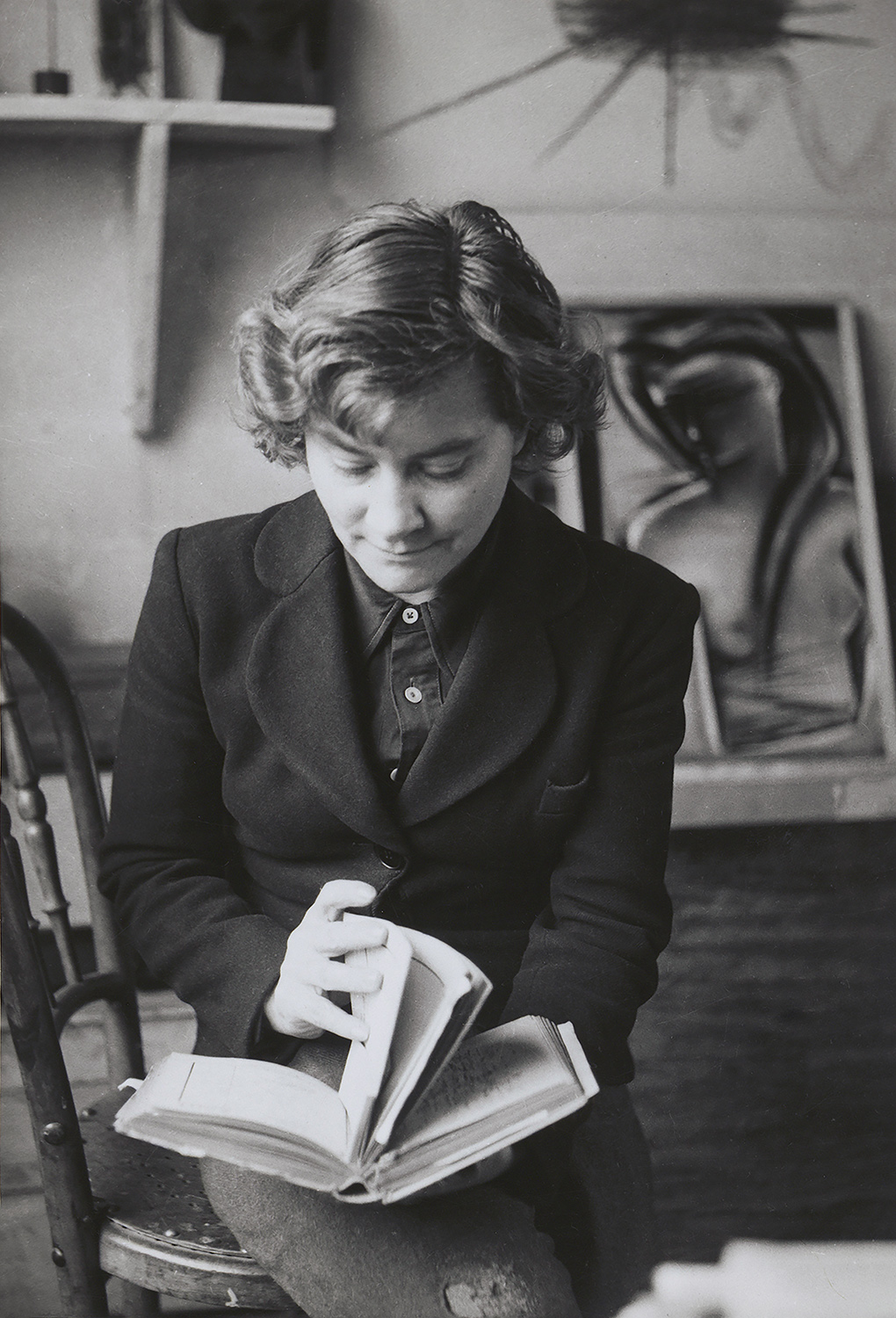
Roberta González, Arcueil, France, c.1949
SELECTED COLLECTIONS
Selected collections
Germany
Nürtingen, Sammlung Domnick
Spain
Alicante, Museo de Arte Contemporáneo de Alicante – MACA>
Barcelone, Musée national d’art de Catalogne
Valence, Institut valencien d’art moderne
France
Antibes, Fondation Hans Hartung et Anna-Eva Bergman
Nantes, Musée des arts de Nantes
Paris, Musée national d’art moderne, Centre Pompidou
Paris, González Administration
Paris, Centre national des arts plastiques
Pau, Musée des Beaux-Arts
Roubaix, La Piscine
Saint-Paul-de-Vence, Fondation Maeght
Vézelay, Musée Zervos – Maison Romain-Rolland
USA
Wellesley, MA, Davis Museum at Wellesley College
SELECTED EXHIBITIONS
Selected exhibitions
Group exhibition, Galerie Castelucho, Paris, France, 1933
Salon des Surindépendants, Paris, France, 1934, 1951
Group exhibition, L’art espagnol contemporain, Musée des Écoles étrangères contemporaines, Jeu de Paume, Paris, France, 1936
Group exhibition, Dessins et pastels par Roberta González et Hans Hartung, Galerie Henriette, Paris, France, 1939
Group exhibition, Art de l’Espagne républicaine : les artistes espagnols de l’École de Paris, Mánes exhibition hall, Prague, Czech Republic, 1946
Group exhibition, Premier salon d’art catalan, Galerie Reyman, Paris, France, 1946
Solo exhibition, Galerie Jeanne Bucher, Paris, France, 1948
Group exhibition, Prix Hallmark, Galerie Wildenstein and Galerie des Beaux-Arts, Paris, France, 1949
Solo exhibition, Galerie Colette Allendy, Paris, France, 1951
Group exhibition, Prix de la critique, Galerie Saint-Placide, Paris, France, 1951
Solo exhibition, Galerie Nina Dausset, Paris, France, 1954
Solo exhibition, Galerie Otto Stangl, Munich, Germany, 1954
Solo exhibition, Peggy de Salles Gallery, Birmingham AL, USA, 1954
Group exhibition, Hommage des artistes espagnols au poète Antonio Machado, Maison de la Pensée française, Paris, France, 1955
Solo exhibition, Galerie Paul Mary, Paris, France, 1955
Solo exhibition, Club Urbis, Madrid, Spain, 1960
Solo exhibition, Galerie Syra, Barcelone, Spain, 1960
Group exhibition, Les Trois González, Galerie de France, Paris, France, then Landau Gallery, Los Angeles, CA, USA, 1965
Solo exhibition, Roberta González, Ombres et lumières, Galerie de France, Paris, France, 1968
Group exhibition, Les Trois González, Galerie del Ateneo, Madrid, Spain, then Palau de la Virreina, Barcelona, Spain, 1968
Group exhibition, Julio González en famille, Château de Tours, France, 2007
Solo exhibition, Roberta González : Le Regard et la mémoire, Musée d’Histoire et d’Art, Bormes-les-Mimosas, France, 2012
Group exhibition, Roberta y Julio González, Instituto Valenciano de Arte Moderno Centro Julio González (IVAM), Valencia, Spain, 2012
Group exhibition, Hans Hartung : Les années de guerre, Musée Zervos, Vézelay, France, 2018
Group exhibition, Picasso et l’exil. Une histoire de l’art espagnol en résistance, Les Abattoirs, Toulouse, France, 2019
Group exhibition, De Miró a Barceló. Un siglo de arte español, Centre Pompidou, Málaga, Spain, 2020
Solo exhibition, Roberta González, l’art de voler de ses propres ailes, Galerie Espace des Femmes, Paris, France, 2022
Solo exhibition, Roberta González, une collection madrilène, Centro de cultura contemporanea Conde Duque, Madrid, Spain, 2023
Solo exhibition, Roberta González dans les collections du Centre Pompidou, Centre Pompidou, Paris, France, 2024
SELECTED BIBLIOGRAPHY
Selected Bibliography
Books and articles
Catherine Valogne, Roberta González, Paris, Le Musée de Poche, 1971
Vicente Aguilera Cerni, Julio, Joan, Roberta González : Itinerario de una dinastía, Barcelona, Polígrafa, 1973
Amanda Herold-Marme, « Roberta González : une artiste de l’entre-deux », Mémoire de Master 2 sous la direction d’Arnauld Pierre, Université Paris – Sorbonne (Paris IV), 2010
Amanda Herold-Marme, « Roberta González : un parcours artistique forgé par la guerre », Lettre du séminaire « Arts et Sociétés », Centre d’histoire de Sciences Po, no 73, 15 April 2014
Amanda Herold-Marme, « La Succession Gonzalez : 75 ans de promotion d’un patrimoine familial », in J. Baiao (ed.), Artists’ Legacies : Preservation, Study, Dissemination, Institutionalization, Actes du colloque, Lisboa, Fundação A. Szenes/Vieira da Silva, 20-21 May 2021
Exhibition catalogs
Luis González Robles, Roberta González, Madrid, Club Urbis, 1960
Pierre Descargues, Joan Gonzalez, Julio Gonzalez, Roberta Gonzalez, Peintures et dessins inédits, Galerie de France, Paris, 1965
Carlos Arean, Joan González, Julio González, Roberta González, exhibition catalog, Sala de Santa Catalina del Ateneo, Madrid, and Palacio de la Virreina, Barcelona, Cuadernos de arte, 1968
Pierre Descargues, Roberta Gonzalez : Ombres et Profils, Galerie de France, Paris, 1968
Artistas españoles de Paris : Praga 1946, Caja de Madrid : Sala de Exposiciones Casa del Monte, Madrid, 1993
Julio González en famille, Château de Tours, 2008
Roberta y Julio González, Instituto Valenciano de Arte Moderno Centro Julio González (IVAM), Valencia, 2012
Roberta González : Le Regard de la Mémoire, Musée d’Histoire et d’Art de Bormes-les-Mimosas, 2012
De Miró a Barceló. Un siglo de arte español, Centre Pompidou, Málaga, 2020
Roberta González, una pequeña colección madrileña, Museo de Arte Contemporáneo Conde Duque, Madrid, 2023
